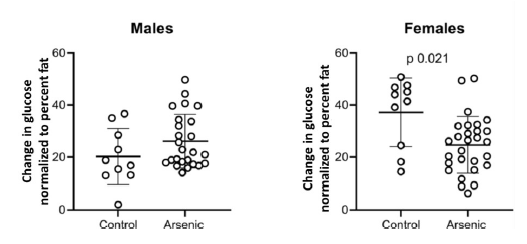Superfund Research Program
Arsenic Exposure Before Conception May Trigger Diabetes in Male Offspring
View Research Brief as PDF(998KB)
Release Date: 04/07/2021
![]() subscribe/listen via iTunes, download(6.2MB), Transcript(86KB)
subscribe/listen via iTunes, download(6.2MB), Transcript(86KB)
Exposure to inorganic arsenic before conception can alter metabolic outcomes in the offspring of mice, with different effects among males and females, according to a new study. Researchers reported, for the first time, a link between changes in gene expression in parents’ reproductive cells and diabetic indicators in offspring.
Inorganic arsenic is found naturally in the earth’s crust and can contaminate drinking water, soil, and food. Previous research has linked prenatal exposure to inorganic arsenic with diabetes, but this is the first study to focus on preconception exposure.
Funded by the NIEHS Superfund Research Program (SRP) and an NIEHS individual research grant, Miroslav Styblo, Ph.D., and Rebecca Fry, Ph.D., of the University of North Carolina at Chapel Hill SRP Center led the study. They looked at changes in gene expression in eggs and sperm as a potential mechanism by which exposure to arsenic before conception may alter metabolic pathways in offspring.
The team exposed male and female mice to drinking water with 200 parts per billion inorganic arsenite, a form of arsenic found in groundwater, for 10 weeks prior to mating. Mice given arsenite water were compared to mice given arsenic-free deionized water. Using RNA sequencing techniques, they assessed gene expression profiles in sperm and immature egg cells, called oocytes. Then they examined the offspring at 11 and 23 weeks of age for changes in body composition and indicators of diabetes, including blood glucose, plasma insulin, and insulin resistance. They also looked for differences in gene expression in pancreatic islets and livers that may be related to gene expression changes in parent reproductive cells.

Indicators of Diabetes
Among parent mice, the researchers found no significant differences in indicators of diabetes related to arsenic exposure.
In male offspring of arsenic-exposed and unexposed mice, the researchers measured the change in blood glucose before and after a glucose challenge, which measures the body's response to a high amount of sugar after fasting. They did not observe a difference between the two groups.
However, offspring of arsenic-exposed mice had higher plasma insulin levels following the glucose challenge and a higher insulinogenic index, a measure of how much insulin is needed to maintain glucose balance in the body. According to the authors, male offspring from parents exposed to arsenic appeared to maintain glucose balance during fasting but required more insulin to support glucose utilization after the challenge.
Female offspring of arsenic-exposed mice had higher body fat percentages compared to female offspring of parents with deionized water. Taking body fat into account, female mice from arsenic-exposed parents had lower blood glucose levels after fasting and after a glucose challenge than female mice whose parents were not exposed to arsenic. They also had lower fasting and post-glucose challenge insulin levels, as well as lower HOMA-IR, an indicator of insulin resistance. These findings pointed to a slightly protective effect that warrants further study, according to the authors.
Uncovering Mechanisms
Arsenic exposure did not result in differences in gene expression in the oocytes from parent mice. Similarly, pathway enrichment analyses did not reveal any disrupted biological pathways that could be explained by arsenic exposure.
In sperm cells from the parent mice, the team found several changes in gene expression related to arsenic exposure. Arsenic-exposed males had differences in genes involved in important pathways related to glucose dysregulation, including focal adhesion and insulin-like growth factor binding, compared to males not exposed to arsenic.
Similar genes and pathways that were altered in the sperm of arsenic-exposed parents were also altered in the livers of their male offspring. According to the researchers, these genes and pathways, which are associated with glucose regulation and diabetes, may provide a mechanistic link between preconception arsenic exposure and diabetes-related outcomes in male offspring.
For More Information Contact:
Rebecca C Fry
University of North Carolina-Chapel Hill
Department of Environmental Sciences and Engineering
140 Rosenau Hall, CB #7431
Chapel Hill, North Carolina 27599
Phone: 919-843-6864
Email: rfry@email.unc.edu
Miroslav Styblo
University of North Carolina-Chapel Hill
2302 Michael Hooker Res. Center
Campus Box 7461
Chapel Hill, North Carolina 27599-7461
Phone: 919-966-5721
Email: styblo@med.unc.edu
To learn more about this research, please refer to the following sources:
- Venkatratnam A, Douillet C, Topping BC, Shi Q, Addo KA, Ideraabdullah FY, Fry RC, Styblo M. 2020. Sex-dependent effects of preconception exposure to arsenite on gene transcription in parental germ cells and on transcriptomic profiles and diabetic phenotype of offspring. Arch Toxicol doi:10.1007/s00204-020-02941-w PMID:33145626
To receive monthly mailings of the Research Briefs, send your email address to srpinfo@niehs.nih.gov.


